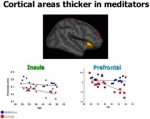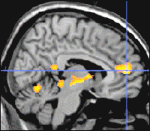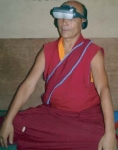Mar 16, 2006
Meditation States and Traits
Psychol Bull. 2006 Mar;132(2):180-211
Authors: Cahn BR, Polich J
18:36 Posted in Meditation & brain | Permalink | Comments (0) | Tags: Positive Technology
Mar 02, 2006
Alpha activity induced by transcendental meditation
Medial profrontal cortex and anterior cingulate cortex in the generation of alpha activity induced by transcendental meditation: a magnetoencephalographic study.
Acta Med Okayama. 2006 Feb;60(1):51-8
Authors: Yamamoto S, Kitamura Y, Yamada N, Nakashima Y, Kuroda S
Previous EEG studies have shown that transcendental meditation (TM) increases frontal and central alpha activity. The present study was aimed at identifying the source of this alpha activity using magnetoencephalography (MEG) and electroencephalography (EEG) simultaneously on eight TM practitioners before, during, and after TM. The magnetic field potentials corresponding to TM-induced alpha activities on EEG recordings were extracted, and we attempted to localize the dipole sources using the multiple signal classification (MUSIC) algorithm, equivalent current dipole source analysis, and the multiple spatio-temporal dipole model. Since the dipoles were mapped to both the medial prefrontal cortex (mPFC) and anterior cingulate cortex (ACC), it is suggested that the mPFC and ACC play an important role in brain activity induced by TM.
18:18 Posted in Meditation & brain | Permalink | Comments (0) | Tags: Positive Technology
Mar 01, 2006
Brain activity before an event predicts later recollection
Brain activity before an event predicts later recollection
Nature Neuroscience, Published online: 26 February 2006
22:34 Posted in Meditation & brain | Permalink | Comments (0) | Tags: Positive Technology
Feb 21, 2006
Meditation may increase the thickness of the cortex
Science and Consciousness Review has interviewed brain researcher Sara Lazar on how meditation affects the brain. Lazar is the author of a recent study, in which magnetic resonance imaging was used to assess cortical thickness in 20 participants with extensive Insight meditation, a technique that involves focusing attention on internal experiences. Findings showed that brain regions associated with attention, interoception and sensory processing were thicker in meditation participants than matched controls, including the prefrontal cortex and right anterior insula. According to Lazar and her colleagues, these results provide preliminary evidence for experience-dependent cortical plasticity associated with meditation practice.

14:35 Posted in Meditation & brain | Permalink | Comments (0) | Tags: Positive Technology, meditation
Feb 15, 2006
Capsules for relaxation

11:25 Posted in Meditation & brain | Permalink | Comments (0) | Tags: Positive Technology
Feb 11, 2006
Cloud

19:45 Posted in Emotional computing, Meditation & brain, Serious games | Permalink | Comments (0) | Tags: emotional computing, serious gaming
Jan 28, 2006
Meditation therapy for anxiety disorders
Meditation therapy for anxiety disorders.
Cochrane Database Syst Rev. 2006;(1):CD004998
Authors: Krisanaprakornkit T, Krisanaprakornkit W, Piyavhatkul N, Laopaiboon M
BACKGROUND: Anxiety disorders are characterised by long term worry, tension, nervousness, fidgeting and symptoms of autonomic system hyperactivity. Meditation is an age-old self regulatory strategy which is gaining more interest in mental health and psychiatry. Meditation can reduce arousal state and may ameliorate anxiety symptoms in various anxiety conditions. OBJECTIVES: To investigate the effectiveness of meditation therapy in treating anxiety disorders SEARCH STRATEGY: Electronic databases searched include CCDANCTR-Studies and CCDANCTR-References, complementary and alternative medicine specific databases, Science Citation Index, Health Services/Technology Assessment Text database, and grey literature databases. Conference proceedings, book chapters and references were checked. Study authors and experts from religious/spiritual organisations were contacted. SELECTION CRITERIA: Types of studies: Randomised controlled trials.Types of participants: patients with a diagnosis of anxiety disorders, with or without another comorbid psychiatric condition.Types of interventions: concentrative meditation or mindfulness meditation. Comparison conditions: one or combination of 1) pharmacological therapy 2) other psychological treatment 3) other methods of meditation 4) no intervention or waiting list.Types of outcome: 1) improvement in clinical anxiety scale 2) improvement in anxiety level specified by triallists, or global improvement 3) acceptability of treatment, adverse effects 4) dropout. DATA COLLECTION AND ANALYSIS: Data were independently extracted by two reviewers using a pre-designed data collection form. Any disagreements were discussed with a third reviewer, and the authors of the studies were contacted for further information. MAIN RESULTS: Two randomised controlled studies were eligible for inclusion in the review. Both studies were of moderate quality and used active control comparisons (another type of meditation, relaxation, biofeedback). Anti-anxiety drugs were used as standard treatment. The duration of trials ranged from 3 months (12 weeks) to 18 weeks. In one study transcendental meditation showed a reduction in anxiety symptoms and electromyography score comparable with electromyography-biofeedback and relaxation therapy. Another study compared Kundalini Yoga (KY), with Relaxation/Mindfulness Meditation. The Yale-Brown Obsessive Compulsive Scale showed no statistically significant difference between groups. The overall dropout rate in both studies was high (33-44%). Neither study reported on adverse effects of meditation. AUTHORS' CONCLUSIONS: The small number of studies included in this review do not permit any conclusions to be drawn on the effectiveness of meditation therapy for anxiety disorders. Transcendental meditation is comparable with other kinds of relaxation therapies in reducing anxiety, and Kundalini Yoga did not show significant effectiveness in treating obsessive-compulsive disorders compared with Relaxation/Meditation. Drop out rates appear to be high, and adverse effects of meditation have not been reported. More trials are needed.
19:05 Posted in Meditation & brain | Permalink | Comments (0) | Tags: Positive Technology
Jan 27, 2006
Meditation potentially capable of increasing susceptibility to epilepsy - A follow-up hypothesis
Meditation potentially capable of increasing susceptibility to epilepsy - A follow-up hypothesis.
Med Hypotheses. 2006 Jan 21;
Authors: Jaseja H
12:43 Posted in Meditation & brain | Permalink | Comments (0) | Tags: Positive Technology
Jan 15, 2006
review of research related to meditation, spirituality, and the elderly
Integrative review of research related to meditation, spirituality, and the elderly.
Geriatr Nurs. 2005 Nov-Dec;26(6):372-7
Authors: Lindberg DA
Recently, increased attention has been given to meditation-relaxation strategies to improve physical health, reduce pain, enhance immune response, improve emotional well-being, and foster spiritual growth. This article reviews research conducted in the last 25 years about meditation and spirituality, in particular as it relates to the health of the elderly. This review supports the hypothesis that meditation can be taught to the elderly, even those with dementia. The results also support the hypothesis that meditation and spiritual practices could promote significant social and emotional benefits for those in social isolation. Specific treatment plan interventions for nursing homes are discussed. Future research should investigate the effectiveness of various types of meditative and spiritual practices to nursing home residents.
12:05 Posted in Meditation & brain | Permalink | Comments (0) | Tags: Positive Technology
Jan 13, 2006
Time for meditation
Via Mind Hacks

Time has an interesting article about neuroscience of meditation. Taking advantage of advanced brain imaging techniques such as fMRI and PET, scholars are casting light on how the practice of meditation affects brain structure and its functions. Moreover, psychological research is collecting evidence that meditation can improve key cognitive capabilities such as attention and memory
10:44 Posted in Meditation & brain | Permalink | Comments (0) | Tags: Positive Technology, meditation
Jan 11, 2006
From Molecular Biology to Anti-aging Cognitive-Behavioral Practices
From Molecular Biology to Anti-aging Cognitive-Behavioral Practices: The Pioneering Research of Walter Pierpaoli on the Pineal and Bone Marrow Foreshadows the Contemporary Revolution in Stem Cell and Regenerative Biology.
Ann N Y Acad Sci. 2005 Dec;1057:28-49
Authors: Bushell WC
Evidence is accruing that a cognitive-behavioral regimen integrating cognitive techniques (meditation-based anti-stress, anti-inflammatory techniques, others), dietary modification ("dietary restriction" or modified dietary restriction), and certain forms of aerobic exercise, may prolong the healthy life span in humans. Recent research has identified some of the likely molecular mediators of these potentially broad-ranging, health-enhancing and anti-aging effects; these include DHEA, interleukins -10 and -4 (IL-10, 1L-4), and especially melatonin. Relatedly, what some are calling a revolution in biology and medicine has been emerging from research on stem cells and regeneration processes more generally. Dogma regarding limitations on the regenerative capacities of adult vertebrates is being cautiously yet enthusiastically revised in the wake of rapidly accumulating discoveries of more types of adult stem cells in mammals, including humans. For example, a recent review by D. Krause of Yale concluded that "in the [adult] bone marrow, in addition to hematopoietic stem cells and supportive stromal cells, there are cells with the potential to differentiate into mature cells of the heart, liver, kidney, lungs, GI tract, skin, bone, muscle, cartilage, fat, endothelium and brain." In addition, very recent studies have shown that DHEA, ILs-10 and -4, and melatonin all possess potential regenerative, including stem cell-activating, properties. More than a quarter of a century ago, Walter Pierpaoli initiated a series of extraordinary studies that demonstrated in experimental animals the potential for dramatic regeneration associated with changes in the pineal gland and bone marrow. This appeared to be not only retardation of aging, but also its reversal. Furthermore, as Pierpaoli was attempting to understand both anti-aging regeneration and oncogenesis, he was focusing on both pro- and anti-mitotic mechanisms: recent research now suggests that there is a nonpathologic, "healthy" form of regeneration that is actually antagonistic to oncogenesis, and that melatonin may be important in this form of regeneration. This paper explores Pierpaoli's pioneering studies in light of recent developments in stem cell and regenerative biology, particularly as related to the regenerative potential associated with certain cognitive-behavioral practices, and includes evidence on this subject presented for the first time.
09:40 Posted in Meditation & brain | Permalink | Comments (0) | Tags: Positive Technology, meditation
Nov 23, 2005
Hypnosis can stop Stroop effect
Via Neurodudes
A new experiments by Raz et al., recently published in the Proceedings of the National Academy of Science, found that hypnotic suggestion affects cognitive control by modulating activity in specific brain areas, namely visual areas and the anterior cingulate cortex, which is involved in conflict monitoring.

Raz et al. Hypnotic suggestion reduces conflict in the human brain, Proceedings of the National Academy of Sciences 2005;
Abstract: Many studies have suggested that conflict monitoring involves the anterior cingulate cortex (ACC). We previously showed that a specific hypnotic suggestion reduces involuntary conflict and alters information processing in highly hypnotizable individuals. Hypothesizing that such conflict reduction would be associated with decreased ACC activation, we combined neuroimaging methods to provide high temporal and spatial resolution and studied highly and less-hypnotizable participants both with and without a suggestion to interpret visual words as nonsense strings. Functional MRI data revealed that under posthypnotic suggestion, both ACC and visual areas presented reduced activity in highly hypnotizable persons compared with either no-suggestion or less-hypnotizable controls. Scalp electrode recordings in highly hypnotizable subjects also showed reductions in posterior activation under suggestion, indicating visual system alterations. Our findings illuminate how suggestion affects cognitive control by modulating activity in specific brain areas, including early visual modules, and provide a more scientific account relating the neural effects of suggestion to placebo.
16:00 Posted in Meditation & brain | Permalink | Comments (0) | Tags: Positive Technology, meditation
Nov 15, 2005
Meditation affects physical structure of the brain
Via Mind Hacks
A new study published in the journal NeuroReport has found evidence that meditation alters brain patterns. The MRI experiment involved 20 participants with extensive Insight meditation experience. Most of the brain regions identified to be changed through meditation were found in the right hemisphere, which is essential for sustaining attention.
Lazar SW, Kerr CE, Wasserman RH, Gray JR, Greve DN, Treadway MT, McGarvey M, Quinn BT, Dusek JA, Benson H, Rauch SL, Moore CI, Fischl B., Meditation experience is associated with increased cortical thickness. Neuroreport. 2005 Nov 28;16(17):1893-1897.
Abstract. Previous research indicates that long-term meditation practice is associated with altered resting electroencephalogram patterns, suggestive of long lasting changes in brain activity. We hypothesized that meditation practice might also be associated with changes in the brain's physical structure. Magnetic resonance imaging was used to assess cortical thickness in 20 participants with extensive Insight meditation experience, which involves focused attention to internal experiences. Brain regions associated with attention, interoception and sensory processing were thicker in meditation participants than matched controls, including the prefrontal cortex and right anterior insula. Between-group differences in prefrontal cortical thickness were most pronounced in older participants, suggesting that meditation might offset age-related cortical thinning. Finally, the thickness of two regions correlated with meditation experience. These data provide the first structural evidence for experience-dependent cortical plasticity associated with meditation practice.
23:20 Posted in Meditation & brain | Permalink | Comments (0) | Tags: Positive Technology, meditation
Sep 05, 2005
Meditation alters perceptual rivalry in Tibetan Buddhist monks
reported in the June 7 issue of Current Biology their results from a series of experiments with 76 monks in Ladakh. The goal of their research was to investigate how certain type of meditation can Researchers found that the skills developed by Tibetan Buddhist monks in their meditation practice strongly influence their experience of binocular rivalry, a perceptual phenomenon that occurs when the brain alternates between viewing different images presented to each eye. The neural processes underlying perceptual rivalry are still unclear but they are thought to be linked with brain mechanisms that regulate attention and conscious awareness.
76 Tibetan Buddhist monks participated in the study. The researchers tested the experience using binocular goggles that prompt visual rivalry. The researchers found that the use of a specific meditation technique, called “one-point meditation” determined a high rate of perceptual dominance. In other words, when they used that technique the normal switching processes of binocular rivalry slowed considerably. This observation suggests that individuals who have trained themselves in meditation techniques can alter the normal fluctuations in the states of their consciousness.
More to explore
Carter, O.L., Presti, D.E., Callistemon, C., Ungerer, Y., Liu, G.B., and Pettigrew, J.D. (2005). Meditation alters perceptual rivalry in Tibetan Buddhist monks. Current Biology, Vol. 15, June 7, 2005, pp. 412-413.
16:20 Posted in Meditation & brain | Permalink | Comments (0) | Tags: Positive Technology, meditation
Apr 18, 2005
Samsung mobile phone uses alpha waves to improve brain memory
From I4U
Samsung introduces the SCH-S350 mobile phone that uses apparently alpha waves to improve brain memory and concentration. This could be straight out of a sci-fi novel, but it is not. It is from a Samsung press-release.

Samsung argued that alpha waves, known to improve memory and concentration, are generated when the phone plays functional music.
The Samsung SCH-S350 is a small slider phone featuring a 0.3MP digital camera, MP3 Player and GPS. The new Samsung mobile phone measures 85mm in length and weighs only 85g.
13:20 Posted in Meditation & brain | Permalink | Comments (0) | Tags: meditation
Jan 04, 2005
Transpersonal Psychology
From Wikipedia, the free encyclopedia.
A major motivating factor behind the initiative to establish this school of psychology was the already published work of Abraham Maslow regarding human peak experiences. Maslow was also one of the initiators behind the publication of the first issue of the Journal of Transpersonal Psychology in 1969, the leading academic journal in the field. This was soon to be followed by the founding of the Association for Transpersonal Psychology in 1972. Today Transpersonal Psychology also includes approaches to health, social sciences and practical arts. According to the Association for Transpersonal psychology the Transpersonal perspective includes such research interests as: Psychology and psychotherapy, Meditation, spiritual paths and practices, Change and personal transformation, Consciousness research, Addiction and recovery, Psychedelic and altered states of consciousness research, Death, dying and near death experience (NDE), Self-realization and higher values, The mind-body connection, Mythology and Shamanism and Exceptional Human Experience (EHE).
However, most psychologists do not hold strictly to traditional schools of psychology; most psychologists take an eclectic approach. Furthermore, the phenomena listed are considered by standard subdisciplines of psychology, religious conversion falling within the ambit of social psychology, altered states of consciousness within physiological psychology, and spiritual life within the psychology of religion. Transpersonal psychologists, however, disagree with the approach to such phenomena taken by traditional psychology, and claim that they have typically been dismissed either as signs of various kinds of mental illnesses or regression to infantile stages of psychosomatic development. One must not confuse transpersonal psychology with parapsychology- a mistake frequently made due to the unenviable academic reputation of both branches, and the eerie atmosphere surrounding the subjects investigated.
Although there are many disagreements with regard to transpersonal psychology, one could succinctly lay out a few basic traits of the field:
* transpersonal psychology is rooted in religious psychological doctrines expounded in: Zen Buddhism, Kabbalah, Gnosticism, Sufism, Vedanta, Taoism and Neoplatonism
* by common consent, the following branches are considered to be transpersonal psychological schools: Jungian Depth Psychology or, more recently rephrased by James Hillman, a follower of Carl Jung as Archetypal Psychology; Psychosynthesis founded by Roberto Assagioli and schools of Abraham Maslow and Robert Tart.
* Some transpersonal psychologists claim other authors, for example William James, as supporting their approach. This is controversial; it is unlikely that James ever used the expression "transpersonal" to describe his approach to psychology.
* Doctrines or ideas of many colorful personalities who were or are "spiritual teachers" in the Western world are often assimilated in the transpersonal psychology mainstream scene: Gurdjieff, Alice Bailey or Ken Wilber. This development is, generally, seen as detrimental to the aspiration of transpersonal psychologists to gain firm and respectable academic status.
All transpersonal psychologies, whichever their differences, share one basic contention: they claim that human beings possess the supraegoic centre of consciousness that is irreducible to all known states of empirical, or, better, "ordinary" consciousness (sleep, waking state, ...). This root of consciousness (and human existence, for some schools) is frequently called "Self" (or "Higher Self"), in order to distinguish it from "self" or "ego", which is equated to the seat of ordinary everyday waking consciousness. However, they differ in the crucial traits they ascribe to the Self:
* the supraegoic root of consciousness (the Self) survives bodily death in some transpersonal schools; for others, it dies with the body
* for ones, the Self is dormant and latent; for others, it is ever watchful and precedes empirical human consciousness
* some think that Self is mutable and potentially expandable; others aver that it is perfect and completely outside of time-space, and that only "ego" is subject to temporal change
Currently, transpersonal psychology (especially Archetypal Psychology of Carl Jung and his followers) is integrated, at least to some extent, to numerous psychology departments in US and European Universities; also, transpersonal therapies are included in many therapeutic practices.
14:40 Posted in Meditation & brain | Permalink | Comments (0) | Tags: Positive Technology, meditation
Dec 09, 2004
Positive Psychology
Martin Seligman and Mihaly Csikszentmihalyi describe this new field of research in the article: Positive Psychology: An Introduction
20:45 Posted in Meditation & brain | Permalink | Comments (0) | Tags: Positive Technology, meditation







